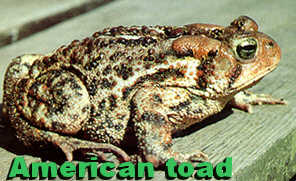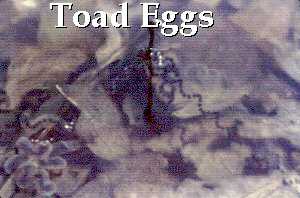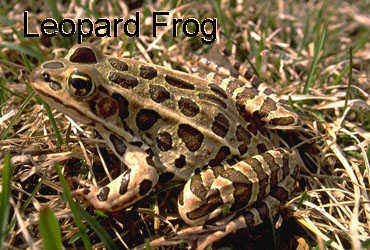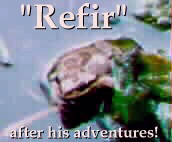Frogs,
Frogs, and Frogs!
Spring '98 Update

Unless your pond is still under deep-freeze, my guess is that
you too are going to sleep each night to a croaking chorus!
The pond nurseryman at "Pond and Garden" here in
Sebastopol, California, told me that people either love that chorus
or hate it and which `side of the fence' they are on quite literally is
usually the deciding factor! We love our frogs but the neighbors
don't?
 So, it was quiet all winter, why the ruckus now?
Well, it's now that time of year when even the amphibians start
thinking of the birds and bees as more than predators and food items.
So, it was quiet all winter, why the ruckus now?
Well, it's now that time of year when even the amphibians start
thinking of the birds and bees as more than predators and food items.
Some frogs may spend the whole year in your pond, but even
those who don't are back now to mate. All frogs (and toads) in the
USA and Canada need water in which to lay their eggs. Hence their
arrival at your pond. Frogs generally lay their eggs in masses of clear
jelly attached to plant leaves under
water.
 Toads are the `bumpy' guys, and are more likely to spend their
summers in your garden than in your pond. They lay their eggs in long
Toads are the `bumpy' guys, and are more likely to spend their
summers in your garden than in your pond. They lay their eggs in long
 strings of clear jelly and also attach
them to underwater leaves in fairly shallow water.
The eggs look like peppercorns at first and then as they develop they
become more elongate.
strings of clear jelly and also attach
them to underwater leaves in fairly shallow water.
The eggs look like peppercorns at first and then as they develop they
become more elongate.
We have Pacific Treefrogs in our pond and when their
polliwogs first hatch they are about the size of this exclamation mark! I
received some e-mail about frog spawn:
Kathy,
I would like to be able to identify Frogspawn and raise
some frogs to ensure that predators don't eat the spawn. I think it
would be a fun thing for my kids and I to do together. Conservation-
wise, do you think it is a good idea?
We have a big, natural, spring-fed pond and the wildlife that it attracts
is of great interest to my family and me. Thanks for the articles. Sylvia
Larson
I replied that I think anything that encourages a young
person's love
of nature is wonderful, and conservation-wise, the amphibians need all
the help they can get!  It would never be a good idea to collect ALL the Frogspawn from your
pond, but collecting can be beneficial as I feel that the mosquito
fish (gambusia) we often put in our ponds to control the mosquitoes seem to consider
the newly emerged polliwogs as dainty appetizers!
It would never be a good idea to collect ALL the Frogspawn from your
pond, but collecting can be beneficial as I feel that the mosquito
fish (gambusia) we often put in our ponds to control the mosquitoes seem to consider
the newly emerged polliwogs as dainty appetizers!
I have found that the Peterson Field Guide Series"A
FIELD GUIDE TO WESTERN REPTILES AND AMPHIBIANS"
has drawings of frog and toad eggs (among others) in the back! I
hadn't even known they were there!
I told Sylvia that I'd just had a whole
class of third graders visit the pond. I was thrilled when they found treefrogs and their
polliwogs, mosquito fish and goldfish, whirligig beetles and pond snails, damselflies and
dragonflies and their nymphs among other things! However since I had I
found that my mosquito fish were eating most of the frog eggs as they
hatched, I had started collecting the frog eggs and putting them into an
aquarium with some pond water. I kept adding more pond water as it
evaporated and also changed the rocks daily from the aquarium
bottom so that the polliwogs always had fresh algae available to eat.
As they matured I began putting them back into the pond. But the 50
mosquito fish I caught in the Laguna last spring were now 200+ and so
hungry they ate the tail right off one of the large polliwogs. So I netted
about 100 of them out of the pond and gave them to my
aforementioned pond nurseryman.
I really enjoyed watching the polliwogs in the aquarium. It was just a small 5 gallon one and sat on our breakfast table where we found watching it to be much more soothing than the morning news. One day I discovered it also harbored hydras and water fleas....and I'd never even seen such things before so I was really thrilled and started doing research on microscopic pond critters. I ended up writing about them for the IPS's June '97 issue. You can read the article at my Pond Wildlife Site (look near the
end for the link at " Microscopic, or close to it". I ended up telling Sylvia to go for it and raise those frogs and mentioned that maybe she'd discover some interesting surprises along the way too! If you try this I'd love to hear about it!
The polliwogs we raised in the aquarium and then released into the pond matured
nicely and became frogs in due time. They
returned to the pond in the Spring of 1998 however and met an
adversary: We had purposely put a Bullfrog polliwog into the pond in
1997 to eat algae. Bullfrogs are not native to our area after all or to anywhere in the
western USA or Canada.
The bullfrog tadpole (tadpole is another name for polliwog) grew up and became a
young Bullfrog, living along the pond edge. Then in 1998 we were
dismayed to find that although a few Treefrogs came and called in the
pond, it never occurred more than one night every few weeks and never two
nights in a row. We were concerned and when we received email
inquiring about Pacific Tree Frogs, I inquired of the writer as to whether
they knew anything about how compatible Bullfrogs and Tree Frogs
were.
The answer was most cryptic!
Dear Kathy,
Thank you for all the helpful links! We will probably find some great help!
Yes, Kathy, your treefrogs may be quiet due to the presence of a bull frog.
"Introduced bullfrogs appear to be so predacious on Pacific Treefrogs that
the two are not found in the same ponds." Reference: Hedges1986, Perrill and
Daniel1983, Schaub and Larsen1978, Whitney and Krebs 1975. Sincerely, Sherry Sorby
We felt horrible about what we had done to the treefrogs and agonized over what to
do about the bullfrog. We remembered that on a nearby walk the previous weekend
looking for dragonflies, we had seen and heard many bullfrogs jump into the pond. One
of the ways that I determine a bullfrog is around is it's characteristic
"Squeak!" it makes while simultaneously
leaping into the water from the pond edge where it usually perches. We decided that
since that pond already had many bullfrogs, that one more wouldn't hurt! So we
determined to catch " Bully"! No easy chore! After several days of attempts,
we finally caught him by having one of us distract him by walking around on the far side
of the pond while the other (my husband!) was sneaking up on him from behind. My
husband had to crawl on his belly [like a reptile?] while carrying my dragonfly catching
net. I would direct him and when he was situated just correctly, I'd tell him to swing.
After the first attempt we learned that you want to aim in front of the bullfrog, so that he
leaps INTO the net! In such a manner Bully was captured and relocated. We wish him
well in his new abode. Now we await the return of any surviving Pacific Treefrogs.
it makes while simultaneously
leaping into the water from the pond edge where it usually perches. We decided that
since that pond already had many bullfrogs, that one more wouldn't hurt! So we
determined to catch " Bully"! No easy chore! After several days of attempts,
we finally caught him by having one of us distract him by walking around on the far side
of the pond while the other (my husband!) was sneaking up on him from behind. My
husband had to crawl on his belly [like a reptile?] while carrying my dragonfly catching
net. I would direct him and when he was situated just correctly, I'd tell him to swing.
After the first attempt we learned that you want to aim in front of the bullfrog, so that he
leaps INTO the net! In such a manner Bully was captured and relocated. We wish him
well in his new abode. Now we await the return of any surviving Pacific Treefrogs.
There are plenty of good reasons to do all we can to encourage the
frogs in our ponds. Not only do the mature frogs (and toads) eat such lily-
chomping critters as earwigs and sowbugs and the like, but the polliwogs EAT
ALGAE!!!!!!
 Your Koi or Goldfish may enjoy dining on a few frogs or pollies, such as this Leopard Frog
which occurs over all but the most western part of North America. But if
you have large frogs such as a Bullfrog, beware: they are
large enough to eat not only small Tree Frogs but also small fish and even small
ducklings!
Your Koi or Goldfish may enjoy dining on a few frogs or pollies, such as this Leopard Frog
which occurs over all but the most western part of North America. But if
you have large frogs such as a Bullfrog, beware: they are
large enough to eat not only small Tree Frogs but also small fish and even small
ducklings!
Before I close with a "Jokes on me" frog story, I
must share
a mystery some of my frog research solved: How can a tiny frog lay
such
a HUGE volume of eggs? Well, the "jelly" is like those
sponges
you buy that are tiny, but when you put them in the water they absorb the liquid
and become many times their original volume!
Now to close with a TRUE LIFE ADVENTURE: Back when I
was doing research
for one of my dragonfly articles, I'd read at Blair
Nikula's "Ode News" site about a technique to assist
in
dragonfly
photography that I'd found quite handy for photos for my CA Dragonflies
web site: you catch the specimen and 'cool' it...in the field you'd
use an iced cooler, but here at home I've just been putting them in the
refrigerator for a few minutes. It makes their metabolism slow down
and
you get a chance at them holding still for a few seconds during which
you
hope to click a photo!
So,.....when I accidentally brought up a tree frog in the net
during
pond maintenance one day, I thought, "Aha!" and
promptly
put him into a plastic container with a little pond water, put the lid
on and popped him into the refer (refrigerator)! Fifteen minutes later when I checked on
him he
still tried to hop out so I put him back for further cooling...and when
I went back later...yeah, you've got it...NO FROG!!!!!!!! :-( I carefully
began a search, taking out one item at a time, looking at ALL sides of
it, then going to the next. He wasn't in the veggies with the cilantro,
or the fruit bin with the apples, I checked all the sodas and grinned as
I came upon the meat bin...frog legs anyone???? Nope, not there
either.
I took out all the bins...not under 'em either. Finally I started taking
things out of the door bins. The refrigerator stood empty. I nearly stood
on my head looking under the bins when I spied a 'shadow' in the
crack
between the door frame and the bin holding the salad dressings! It
was
him! At 40 F. that little bugger had jumped hard enuf to pop the top off
the deli container I'd had him in and had gotten around quite a bit!!!  After all, in the wild he'd survived much cooler temperatures than 40 F.!
At this point I was exhausted so I just put him VERY SECURELY back
into
the refrigerator for "recooling". Then when my husband got
home
from work too, we had a joint photo session. It was successful and
here
is "Refir" as I've taken to referring to him.
After all, in the wild he'd survived much cooler temperatures than 40 F.!
At this point I was exhausted so I just put him VERY SECURELY back
into
the refrigerator for "recooling". Then when my husband got
home
from work too, we had a joint photo session. It was successful and
here
is "Refir" as I've taken to referring to him.
He's a Pacific Treefrog, about 1" long in all. He and 4-6 others
sang
us to sleep each night in the Spring of `97 and we wonder about the stories he must be
telling
the others and we wonder if he became Bullfrog food in `98!
As usual, Kathy would love to hear your "Critter"
stories.
And she reminds you to consider your pond a mini-game refuge.
Please respect
its native inhabitants.email
Kathy!
The Biggs report that their pond is looking beautiful and bringing them so much joy!
Visit their Bigsnest wildlife pond
Next issue "Critters" will explore the
mosquito life in
your pond!
 Toads are the `bumpy' guys, and are more likely to spend their
summers in your garden than in your pond. They lay their eggs in long
Toads are the `bumpy' guys, and are more likely to spend their
summers in your garden than in your pond. They lay their eggs in long
 strings of clear jelly and also attach
them to underwater leaves in fairly shallow water.
The eggs look like peppercorns at first and then as they develop they
become more elongate.
strings of clear jelly and also attach
them to underwater leaves in fairly shallow water.
The eggs look like peppercorns at first and then as they develop they
become more elongate.

 So, it was quiet all winter, why the ruckus now?
Well, it's now that time of year when even the amphibians start
thinking of the birds and bees as more than predators and food items.
So, it was quiet all winter, why the ruckus now?
Well, it's now that time of year when even the amphibians start
thinking of the birds and bees as more than predators and food items.
 It would never be a good idea to collect ALL the Frogspawn from your
pond, but collecting can be beneficial as I feel that the mosquito
fish (gambusia) we often put in our ponds to control the mosquitoes seem to consider
the newly emerged polliwogs as dainty appetizers!
It would never be a good idea to collect ALL the Frogspawn from your
pond, but collecting can be beneficial as I feel that the mosquito
fish (gambusia) we often put in our ponds to control the mosquitoes seem to consider
the newly emerged polliwogs as dainty appetizers!
 it makes while simultaneously
leaping into the water from the pond edge where it usually perches. We decided that
since that pond already had many bullfrogs, that one more wouldn't hurt! So we
determined to catch " Bully"! No easy chore! After several days of attempts,
we finally caught him by having one of us distract him by walking around on the far side
of the pond while the other (my husband!) was sneaking up on him from behind. My
husband had to crawl on his belly [like a reptile?] while carrying my dragonfly catching
net. I would direct him and when he was situated just correctly, I'd tell him to swing.
After the first attempt we learned that you want to aim in front of the bullfrog, so that he
leaps INTO the net! In such a manner Bully was captured and relocated. We wish him
well in his new abode. Now we await the return of any surviving Pacific Treefrogs.
it makes while simultaneously
leaping into the water from the pond edge where it usually perches. We decided that
since that pond already had many bullfrogs, that one more wouldn't hurt! So we
determined to catch " Bully"! No easy chore! After several days of attempts,
we finally caught him by having one of us distract him by walking around on the far side
of the pond while the other (my husband!) was sneaking up on him from behind. My
husband had to crawl on his belly [like a reptile?] while carrying my dragonfly catching
net. I would direct him and when he was situated just correctly, I'd tell him to swing.
After the first attempt we learned that you want to aim in front of the bullfrog, so that he
leaps INTO the net! In such a manner Bully was captured and relocated. We wish him
well in his new abode. Now we await the return of any surviving Pacific Treefrogs.
 Your Koi or Goldfish may enjoy dining on a few frogs or pollies, such as this Leopard Frog
which occurs over all but the most western part of North America. But if
you have large frogs such as a Bullfrog, beware: they are
large enough to eat not only small Tree Frogs but also small fish and even small
ducklings!
Your Koi or Goldfish may enjoy dining on a few frogs or pollies, such as this Leopard Frog
which occurs over all but the most western part of North America. But if
you have large frogs such as a Bullfrog, beware: they are
large enough to eat not only small Tree Frogs but also small fish and even small
ducklings!
 After all, in the wild he'd survived much cooler temperatures than 40 F.!
At this point I was exhausted so I just put him VERY SECURELY back
into
the refrigerator for "recooling". Then when my husband got
home
from work too, we had a joint photo session. It was successful and
here
is "Refir" as I've taken to referring to him.
After all, in the wild he'd survived much cooler temperatures than 40 F.!
At this point I was exhausted so I just put him VERY SECURELY back
into
the refrigerator for "recooling". Then when my husband got
home
from work too, we had a joint photo session. It was successful and
here
is "Refir" as I've taken to referring to him.